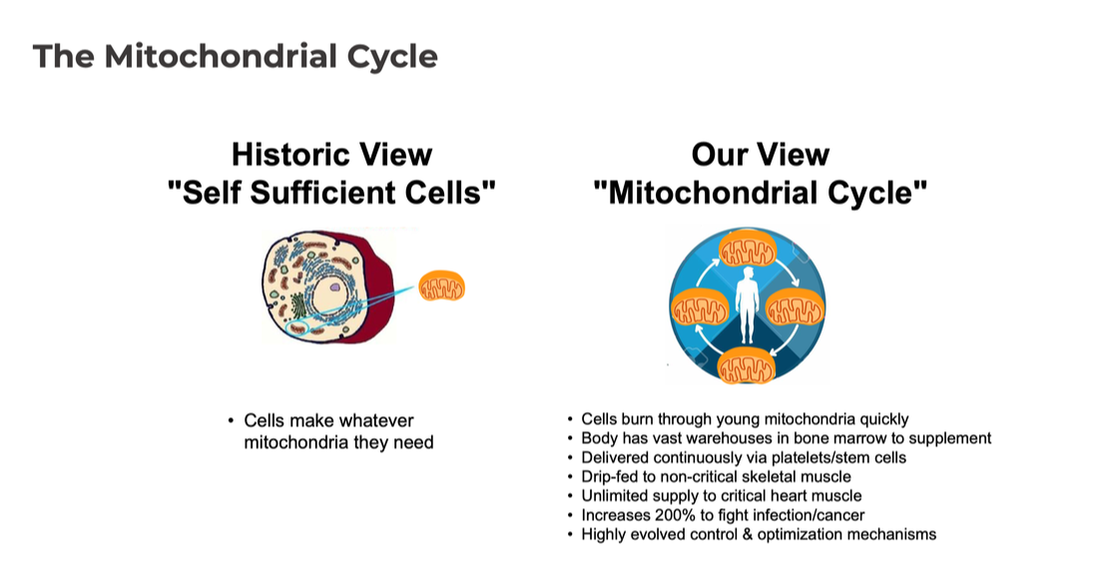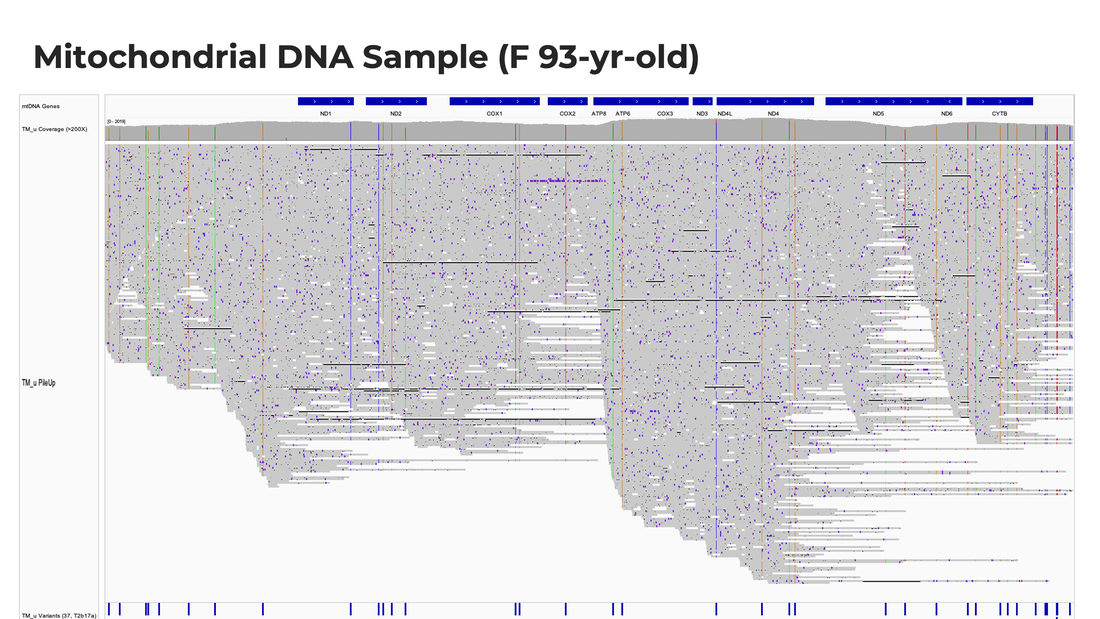|
Mitochondria have been the holy grail of medicine, but no one has cracked the code until now
Mitochondrial energy declines as we age, causing a wide array of chronic diseases. Scientists have tried to fix this problem with drugs that bolster membranes, reduce excess fusion, and increase mitophagy. However, these have not translated well into humans because the heart of the problem is the mitochondrial genetic code (mtDNA), not easily addressed by traditional drugs. At Mitrix we have created an array of technologies and infrastructure, aiming to reverse mitochondrial mtDNA degeneration on a global scale. |
Mitochondrial DNA & Aging
|
We start life with a large inventory of healthy mitochondrial DNA, but over time, as our mitochondria replicate, these mtDNA start to accrue errors. The body has quality control strategies, but eventually the degeneration causes significant energy decline inside cells. In parallel, there is a similar degeneration of the nuclear DNA. These combined degenerations, plus accumulating waste products, drive disease and aging. Reversing this genetic damage is not generally feasible with simple chemicals or drugs.
Want more info? See video - short interview on Mitochondrial Degeneration |
Mitochondrial Bioreactor
|
The bioreactor grows 'young" mitochondria in large quantities, then wraps them in a special coating, with receptors to target specific organs. The goal is to produce bioreactor-grown mitochondria on an industrial scale, a "tool kit" of many different types of mitochondria that can be used by clinicians to regenerate different organs, sufficient to supplement every human being over the age of 55 and reduce severity of a wide array of diseases.
Want more info? See overview video Read peer-reviewed paper on coating technology |
Mitlets
|
Researchers in the past decade have found that mitochondria don't just sit in cells, but in fact constantly transfer around the body. Everyday, hundreds of billions are transferred through the bloodstream, brain, heart, and other organs, in order to supplement cells in need. Many of these mobile mitochondria are encased in extracellular vesicles - what we term "Mitlets."
Mitlets are a "natural fountain of youth" within the body, used to balance and preserve healthy cellular energetics; an extraordinary evolutionary adaptation to increase survival and longevity of species. They can be isolated, transplanted, grown, and manipulated, presenting broad potential for disease-modifying treatments. Want more info? Read press release Read 2014 paper describing discovery of mitlets Read article in Longevity Technology |
Mitochondrial Transplantation
|
There are now many different techniques for transplanting mitochondria: between tissues in the body, or from a donor (family member for example) and patient. Cells readily "absorb" transplanted mitochondria and put them to use inside the cell. Since mitochondria require a lot of energy to make, this conveys significant evolutionary and survival advantage. At Mitrix we have tested transplantation, with excellent and predictable results, in the immune system, retina, brain, and skin.
For example, young mitochondria transferred into the bloodstream of older mice have been shown to reliably "reverse the age" of the immune system - showing dramatic improvements in the survival of mice with life-threatening viral or bacterial infections.. Imagine if this treatment was scaled up to help the elderly human patients fight infection and avoid hospitalization, across the globe? Similar studies have been done for neurodegeneration (Alzheimer's, Parkinson's, and ALS), retinal (macular degeneration and glaucoma) and skin (aging and wound healing.) Want more info? See overview video Article on our work Our peer-reviewed paper on results of Alzheimer's test Overview of field from UC Irvine Our paper on results of infectious disease tests Our paper on in-vitro results |
Mitochondrial Cycle Theory
|
Not only do mitochondria transfer naturally throughout the body, but this process seems intelligently controlled. Our theory, called "The Mitochondrial Cycle of the Body", proposes that the human body has large reservoirs of young, pristine mitochondria (mtDNA) in the bone marrow or other areas, which are slowly rationed to peripheral tissues over time to replace mitochondria damaged during replication. This supplemental flow of mitochondria are one of nature's tools for producing long-lifespan species.
By applying Mitochondrial Cycle Theory, we can re-interpret an array of chronic diseases which have defied understanding. Mitochondrial Cycle and Cellular Energetics fill a significant blind spot in the understanding of disease. Want more info? See video - short interview on Mitochondrial Cycle See video - longer lecture and discussion |
Cellular Energetics Research
|
The study of "Cellular Energetics" is a new way to understand disease states and drug translation in older patients. At Mitrix, we've been lucky to collaborate with researchers at Universite Laval, Quebec, and the UConn Technology Incubator Center (TIP), to create novel lab techniques that enable highly accurate, detailed studies of mitochondria in cellular operations.
In the lab, we can remove a certain number of mitochondria and see a predictable reduction in energy production, resulting in a specific reduction in activity. For example, reduction of energy in immune cells may yield a reduction in speed of seeking out and eliminating pathogens. If the cell restores depleted mitochondria by replication, or is given new mitochondria from external sources, we see a corresponding increase in energy production/performance. Cells may also show energy reductions due to mutation or age-related degeneration of mtDNA. Mitochondria may be loaned between cells or distributed from storehouses, as needed, to restore or maintain function of organs. This paints a picture of the human body as a sophisticated energy distribution and management system at the molecular, cellular, and species levels, with mitochondria being the quanta of biological energy engaged in a billion-year-old dance with information-dense nuclear DNA; energy and information joined to create complexity. Want more info? See overview video Article on our work |
MitoClock
|
To manage a mitochondrial aging platform, it makes sense to have a measurement tool to accurately measure the degeneration of mitochondrial DNA in the body. We have partnered with top genetic scientists to create an experimental tool called "MitoClock." MitoClock uses small, non-invasive samples, processed at an advanced genetic testing lab and analyzed by a proprietary machine learning algorithm, to estimate the biological “age” of your mitochondria and how many years they will continue functioning properly.
MitoClock is still experimental and imprecise and should not under any circumstances be used to make medical decisions. Want more info? Visit MitoClock Page |
|
NOTE: THESE CONCEPTS ARE ALL THEORETICAL/EXPERIMENTAL AND HAVE NOT BEEN APPROVED FOR HUMAN USE. SEE DISCLAIMER
|







